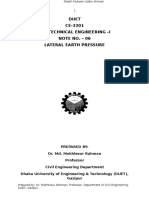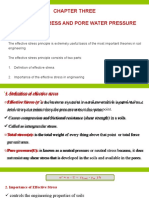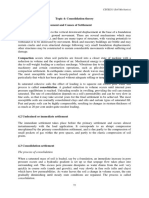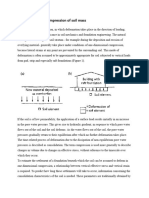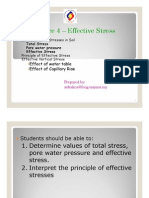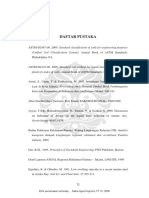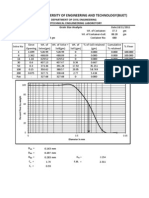Compressibility of Soils: S S + S + S Total Settlement
Uploaded by
biniCompressibility of Soils: S S + S + S Total Settlement
Uploaded by
biniSoil Mechanics-I(CENG-2202) Chapter 4 : Compressibility of soils
4. COMPRESSIBILITY OF SOILS
4.1 INTRODUCTION
Foundations of structures usually rest on soil. Due to the additional stress introduced by a foundation or
due to other loadings, a soil mass will compress. This compression is a sum of different and distinct
processes:
a. Deformation of soil particles
b. Relocation of soil particles, and
c. Expulsion of water or air from the void spaces
In general, soil settlement caused by different loadings can be categorized into three categories:
i. Immediate settlement (or elastic settlement)
Such a settlement is caused by the elastic deformation of dry soil and of moist and saturated soils without
any change in the moisture content. Immediate settlement calculations are generally based on equations
derived from the theory of elasticity.
ii. Primary consolidation settlement
The volume of saturated soils under pressure will decrease due to the expulsion of water from the void
spaces. The associated settlement is known as primary consolidation settlement. It is usually the
predominant type of settlement in fine grained soils, especially in clays.
iii. Secondary consolidation settlement
This type of settlement is observed in saturated cohesive soils and is the result of the plastic adjustment
of soil fabrics. If follows primary consolidation settlement when soil is under a constant effective stress.
The total settlement of a foundation can then be given by
ST = Sc + Ss + Se
where ST = total settlement
Sc = primary consolidation settlement
Ss = secondary consolidation settlement
Se = immediate settlement
The total settlement obtained in this fashion must be within acceptable limits for any structure. For most
practical purposes, the magnitude of the elastic settlement can be ignored compared to the consolidation
settlements. Discussion here shall hence be limited to consolidation settlement. But it must be noted that
the volume change due to expulsion of air is treated in geotechnical engineering under the title
compaction characteristics of soils.
Prior to discussion of soil settlements, discussing the nature of stresses in soils must be presented. It is
due to stresses that soils undergo settlements.
- 47 -
Department of Civil Engineering, Faculty of Technology
Addis Ababa University
Soil Mechanics-I(CENG-2202) Chapter 4 : Compressibility of soils
4.2 EFFECTIVE STRESS
Stresses in a soil mass may be caused by the self weight of the soil, and also by the external loads which
may be applied to the soil. The pattern of stresses caused by the external loads is usually a complicated
one, and the same may be the case for stresses induced by self weight of soil. However, there is one
common situation in which the self weight of the soil gives rise to a very simple pattern of stresses-that is
when the ground surface is horizontal and the nature of soil does not vary significantly in the horizontal
direction. The stress caused in such a situation at a point in a soil mass is called the geostatic stress.
However, if external loading contributes to this stress, the stress will simply be called as the total stress.
In the geostatic situation, there cannot occur any shear stresses upon the vertical and horizontal planes
within the soil. Hence, the vertical geostatic stress, say σz, may be computed simply by considering the
weight of soil and weight of water above that depth.
In the figure above a soil column is standing with no seepage allowed. The total stress at the elevation of
point A can be obtained from
σ = Hγ w + (H A − H )γ sat
This total stress can be divided into two parts
1. Effective stress or intergranular stress, σ’ – the sum of the vertical components of the forces
developed at the points of contact of the solid particles per unit cross-sectional area of the soil
mass.
2. Pore water pressure or neutral stress, u – a portion carried by water in the continuous void
spaces. This portion acts with equal intensity in all directions.
- 48 -
Department of Civil Engineering, Faculty of Technology
Addis Ababa University
Soil Mechanics-I(CENG-2202) Chapter 4 : Compressibility of soils
The total stress can thus be rewritten as
σ =σ' + u
or
σ'= σ − u
Substituting the values for the total stress and the pore water pressure into this equation
Hence, it can be easily stated that the effective stress at a point in a soil mass will be equal to its
submerged unit weight multiplied by the depth of soil mass up to the considered point.
The effective stress principle is arguably the most important principle in geotechnical engineering. The
compressibility and shearing resistance of a soil depend to a great extent on the effective stress. Thus
the concept of effective stress is significant in solving geotechnical engineering problems, such as lateral
earth pressure on retaining structures, the load bearing capacity and settlement of foundations, and the
stability of earth slopes.
4.3 CONSOLIDATION SETTLEMENT
When a clayey soil is subjected to loading, elastic settlement occurs immediately. If the loading
continues, then its volume goes on compressing gradually due to removal of water from the pores. This
major compression, which goes on for months and years, is the consolidation, and strictly called the
primary consolidation. During this process, the transfer of load from the soil pores to the soil grains
takes place. Due to this gradual transfer of the excess hydrostatic pressure from the water to the soil
solids, a change in the initial structure of the soil mass (plastic adjustment of soil fabric) may occur, which
may cause some compression, called secondary compression or secondary consolidation.
The time-dependent deformation of saturated clayey soil can best be understood by considering a simple
model that consists of cylinder with a spring at its center and filled with water. Three cases may be
observed.
a. Place a load, P, on the spring and keep the valve closed. There will be no deformation of the
spring in this case. The excess hydrostatic pressure at this time can be given as
P
∆u =
A
b. If the valve is opened, the water will flow outward. This flow will be accompanied by a reduction
of the excess hydrostatic pressure and an increase in the compression of the spring. If Ps and Pw
denote portions of P carried by the spring and the water respectively, after valve opening
P
Ps > 0 and Pw < P, i.e. ∆u <
A
- 49 -
Department of Civil Engineering, Faculty of Technology
Addis Ababa University
Soil Mechanics-I(CENG-2202) Chapter 4 : Compressibility of soils
c. Finally the excess hydrostatic pressure dissipates, and the system will reach a state of
equilibrium, and thus
Ps = P and Pw = 0
These equations mean that after the excess pore water pressure dissipates the additional stress
P will be carried by the soil skeleton, i.e. ∆σ = σ '
- 50 -
Department of Civil Engineering, Faculty of Technology
Addis Ababa University
Soil Mechanics-I(CENG-2202) Chapter 4 : Compressibility of soils
One-dimensional laboratory consolidation test
The process of consolidation settlement is studied in the laboratory by the one-dimensional consolidation
test. This test is performed in a consolidometer (sometimes referred to as an oedometer). The schematic
diagram of a consolidometer is shown below.
The soil specimen is placed inside a metal ring with two porous stones, one at eh top of the specimen
and another at the bottom. The specimens are usually 64mm in diameter and 25mm thick. The load on
the specimen is applied through a lever arm, and compression is measured by a micrometer dial gauge.
The specimen is kept under water during the test. Each load is usually kept for 24 hours. After that, the
load is usually doubled, which doubles the pressure on the specimen, and the compression
measurement is continued. At the end of the test, the dry weight of the specimen is determined.
From load and deformation values, a plot of deformation versus time for a given load increment is
prepared.
- 51 -
Department of Civil Engineering, Faculty of Technology
Addis Ababa University
Soil Mechanics-I(CENG-2202) Chapter 4 : Compressibility of soils
Form this plot; we can observe three distinct stages, which may be described as:
Stage I Initial compression, which is caused mostly by preloading
Stage II Primary consolidation
Stage III Secondary consolidation
After time-deformation plots for various loadings are obtained in the laboratory, it is necessary to study
the change in the void ratio of the specimen with pressure. The procedure is described as follows:
Specimen
area =A
Solid
1. Calculate the height of solids, Hs, in the specimen using the equation
- 52 -
Department of Civil Engineering, Faculty of Technology
Addis Ababa University
Soil Mechanics-I(CENG-2202) Chapter 4 : Compressibility of soils
2. Calculate the initial height of voids as
Hv = H – Hs
3. Calculate the initial void ratio, eo, of the specimen
4. For the first incremental loading, σ1, which causes a deformation ∆H1, calculate the change in
void ratio as
∆H 1
∆e1 =
Hs
5. Calculate the new void ratio after consolidation caused by the pressure increment as
e1 = eo – ∆e1
For the next loading, σ2 (that equals the cumulative load per unit area of the specimen), which
causes additional deformation ∆H2, the void ratio at the end of consolidation can be calculated as
∆H 2
e2 = e1 −
Hs
At this time, total stress σ2 = effective stress, σ’2. Proceeding in a similar manner, one can obtain the void
ratios at the end of the consolidation for all load increments. The effective stress and the corresponding
void ratios (e) at the end of consolidation are plotted on semi logarithmic graph paper. The typical shape
of such a plot is shown below.
- 53 -
Department of Civil Engineering, Faculty of Technology
Addis Ababa University
Soil Mechanics-I(CENG-2202) Chapter 4 : Compressibility of soils
This figure shows that the upper part of the e-log σ’ plot is somewhat curved with a gentle slope, followed
by a linear relationship for the void ratio with log σ’ having a steeper slope. This is an important
phenomenon that required further explanation.
A soil in the field at some depth has been subjected to a certain maximum effective past pressure in its
geologic history. This maximum effective past pressure may be equal to or less than the existing effective
overburden pressure at the time of sampling. The reduction of effective pressure in the field may be
caused by natural geologic processes or human activities. During sampling, the existing effective
overburden pressure is also released, which results in some expansion. When this specimen is subjected
to a consolidation test, a small amount of compression (i.e. a small change in void ratio) will occur when
the effective pressure applied is less than the maximum effective overburden pressure in the field to
which the soil has been subjected to in the past. When the effective pressure on the specimen becomes
greater than the maximum effective past pressure, the change in void ratio is much larger, and the e-log
σ’ relationship is practically linear with a steeper slope.
This relationship can be verified in the lab by loading the specimen to exceed the maximum effective
overburden pressure, and then unloading and reloading again. The e-log σ’ plot for such cases is shown
below, in which cd represents the unloading and dfg represents the reloading process.
This discussion leads to two basic definitions of clay based on stress history:
1. Normally consolidated clays, whose present effective overburden pressure is the maximum
pressure that the soil was subjected to in the past
2. Overconsolidated clays, whose present effective overburden pressure is less than that which
the soil experienced in the past. The maximum effective past pressure is called the
preconsolidation pressure.
- 54 -
Department of Civil Engineering, Faculty of Technology
Addis Ababa University
Soil Mechanics-I(CENG-2202) Chapter 4 : Compressibility of soils
The preconsolidation pressure can be obtained from the e-log σ’ plot following the procedure suggested
by Casagrande.
i. By visual inspection, establish point a, at which the e-log σ’ plot has a minimum radius of
curvature
ii. Draw horizontal line ab
iii. Draw the line ac tangent to the curve at a
iv. Draw the line ad, which is the bisector of the angle bac
v. Project the straight-line portion gh of the plot back to intersect line ad at f. The abscissa of point f
is the preconsolidation pressure, σ’c
The overconsolidation ratio (OCR) for a soil can now be defined as
σ 'c
OCR =
σ'
where σ’c = preconsolidation pressure of a specimen
σ’ = present effective vertical pressure
Settlement calculation from one-dimensional primary consolidation
- 55 -
Department of Civil Engineering, Faculty of Technology
Addis Ababa University
Soil Mechanics-I(CENG-2202) Chapter 4 : Compressibility of soils
Soil
Solid
Let us consider a saturated soil layer of thickness H and cross sectional area A under an existing
average effective overburden pressure σ’o. Because of an increase of effective pressure, ∆σ’, let the
primary consolidation settlement be Sc. Thus the change in volume can be given by
∆V = Vo – V1 = HA – (H –Sc) A = ScA
But the volume change is due to the change in the volume of voids, ∆Vv
∆Vv = ∆eVs
But, the volume of solids
V AH
Vs = o =
1 + eo 1 + eo
Thus
AH
∆V = ScA = ∆eVs = ∆e
1 + eo
or
∆e
Sc = H
1 + eo
For normally consolidated clays that exhibit a linear e-log σ’ relationship
∆e = Cc [ log (σ’o + ∆σ’) - log σ’ ]
Where Cc is the slope of the e-log σ’ plot and is defined as the compression index. Substitution of this
value into the equation of Sc yields
Cc H ⎛ σ ' + ∆σ ' ⎞
Sc = log⎜⎜ o ⎟⎟
1 + eo ⎝ σ ' o ⎠
In overconsolidated clays, for σ’o + ∆σ’ ≤ σ’c, the slope of the plot is defined as the swell index, Cs.
Hence,
- 56 -
Department of Civil Engineering, Faculty of Technology
Addis Ababa University
Soil Mechanics-I(CENG-2202) Chapter 4 : Compressibility of soils
∆e = Cs [ log (σ’o + ∆σ’) - log σ’ ]
The settlement would then be
Cs H ⎛ σ ' + ∆σ ' ⎞
Sc = log⎜⎜ o ⎟⎟
1 + eo ⎝ σ 'o ⎠
If σ’o + ∆σ’ > σ’c, then
Cs H ⎛σ' ⎞ C H ⎛ σ ' + ∆σ ' ⎞
Sc = log⎜⎜ c ⎟⎟ + c log⎜⎜ o ⎟⎟
1 + eo σ
⎝ o⎠
' 1 + eo ⎝ σ ' c ⎠
However, if the e-log σ’ curve is available, one can simply pick ∆e off the plot for the appropriate range of
pressures. This number may be substituted directly into the equation of Sc.
Several empirical relations have also been suggested for Cc and Cs. The common formulae for clays are
the following.
Cc = 0.009 (LL-10)
⎡ LL(%) ⎤
Cs = 0.0463⎢ Gs
⎣ 100 ⎥⎦
SECONDARY CONSOLIDATION SETTLEMENT
We have noted earlier that at the end of primary consolidation settlement some settlement is observed
due to the plastic adjustment of soil fabrics. This stage of consolidation is called secondary consolidation.
During this phase the plot of deformation against the log of time is practically linear. The variation of the
void ratio, e, with the time t for a given load increment is shown below.
From this figure, the secondary compression index, Cα, can be defined as
- 57 -
Department of Civil Engineering, Faculty of Technology
Addis Ababa University
Soil Mechanics-I(CENG-2202) Chapter 4 : Compressibility of soils
∆e ∆e
Cα = =
log t 2 − log t1 log⎛ t 2 ⎞
⎜ t ⎟
⎝ 1⎠
The magnitude of the secondary consolidation can be calculated as
S s = C 'α H log⎛⎜ t 2 ⎞⎟
⎝ t1 ⎠
Cα
where C 'α =
1 + eP
eP = void ratio at the end of primary consolidation
H = thickness of clay layer
The values of C’α as observed in various natural deposits are as follows:
• Overconsolidated clays = 0.001 or less
• Normally consolidated clays = 0.005 to 0.03
• Organic soil = 0.04 or more
Secondary consolidation settlement is more important than primary consolidation settlement in organic
and highly compressible inorganic soils. In overconsolidated inorganic clays, the secondary compression
index is very small and of less practical significance.
- 58 -
Department of Civil Engineering, Faculty of Technology
Addis Ababa University
You might also like
- One Dimensional Consolidation Test - Oedometer Test0% (1)One Dimensional Consolidation Test - Oedometer Test22 pages
- Consolidation Test: The University of Hong Kong Department of Civil Engineering Soil Mechanics - CIVL2006100% (1)Consolidation Test: The University of Hong Kong Department of Civil Engineering Soil Mechanics - CIVL200620 pages
- Review Module: - Slope Stability and Terzaghi's Bearing Capacity0% (1)Review Module: - Slope Stability and Terzaghi's Bearing Capacity2 pages
- 26901322018_CE(PC)504_Soil Mechanics-IINo ratings yet26901322018_CE(PC)504_Soil Mechanics-II19 pages
- Dr Ahmed Soil Mechanics Notes Chapter 4No ratings yetDr Ahmed Soil Mechanics Notes Chapter 448 pages
- DR Ahmed Soil Mechanics Notes Chapter 4No ratings yetDR Ahmed Soil Mechanics Notes Chapter 448 pages
- Dr Ahmed Soil Mechanics Notes Chapter 4No ratings yetDr Ahmed Soil Mechanics Notes Chapter 447 pages
- Soil Mechanics Lectures 8 (Compressibility, Stress and SettlementdistributionNo ratings yetSoil Mechanics Lectures 8 (Compressibility, Stress and Settlementdistribution25 pages
- Module-7-Soil-Mech-Stresses-of-Soils-In-situNo ratings yetModule-7-Soil-Mech-Stresses-of-Soils-In-situ10 pages
- DR Ahmed Soil Mechanics Notes Chapter 7No ratings yetDR Ahmed Soil Mechanics Notes Chapter 741 pages
- TR232 Chapter 2 Compressibility of SoilsNo ratings yetTR232 Chapter 2 Compressibility of Soils56 pages
- Duet CE-3301 Geotechnical Engineering - INo ratings yetDuet CE-3301 Geotechnical Engineering - I37 pages
- Chapter 3 Setlment of shallow foundation (2)No ratings yetChapter 3 Setlment of shallow foundation (2)47 pages
- Soil Mechanics Chapter 7.compressibility of Soil FULLNo ratings yetSoil Mechanics Chapter 7.compressibility of Soil FULL29 pages
- Federal University of Technology Minna: Period of Early Development in Soil EngineeringNo ratings yetFederal University of Technology Minna: Period of Early Development in Soil Engineering11 pages
- Seismic Analysis of Underground Water TaNo ratings yetSeismic Analysis of Underground Water Ta5 pages
- Proc No 125 1998 The Customs Authority AmendmentNo ratings yetProc No 125 1998 The Customs Authority Amendment2 pages
- Proc No 249 2001 Export Trade Duty Incentive Scheme Establ - 2No ratings yetProc No 249 2001 Export Trade Duty Incentive Scheme Establ - 28 pages
- Proc No 226 2000 Petroleum Operations Income Tax AmendmentNo ratings yetProc No 226 2000 Petroleum Operations Income Tax Amendment1 page
- The Idea of BEM and Its Advantages The 2D Potential Problem Numerical ImplementationNo ratings yetThe Idea of BEM and Its Advantages The 2D Potential Problem Numerical Implementation27 pages
- Proc No 287 2002 Tax On Coffee Exported From Ethiopia AmeNo ratings yetProc No 287 2002 Tax On Coffee Exported From Ethiopia Ame1 page
- Proc No 249 2001 Export Trade Duty Incentive Scheme Establ - 2No ratings yetProc No 249 2001 Export Trade Duty Incentive Scheme Establ - 28 pages
- Proc No 368 2003 Re Establishment and Modernization of CusNo ratings yetProc No 368 2003 Re Establishment and Modernization of Cus8 pages
- Aait, Civil Engineering Department, Geotechnical Engineering - CourseoutlineNo ratings yetAait, Civil Engineering Department, Geotechnical Engineering - Courseoutline2 pages
- Advanced Foundation Engineering Course Outline AASTU100% (2)Advanced Foundation Engineering Course Outline AASTU2 pages
- Geotechnical Engineering Assignment 4 Advanced Foundation Engineering (CENG 6204)No ratings yetGeotechnical Engineering Assignment 4 Advanced Foundation Engineering (CENG 6204)1 page
- Soil and Water Conservation: Department of Agriculture Engineering100% (1)Soil and Water Conservation: Department of Agriculture Engineering14 pages
- Origin of The Soil Texture Classification System Used in JapanNo ratings yetOrigin of The Soil Texture Classification System Used in Japan11 pages
- MOD-02 - Planning For Earthwork ConstructionNo ratings yetMOD-02 - Planning For Earthwork Construction32 pages
- Review and Critical Examination of Fine-Grained Soil Classification SystemsNo ratings yetReview and Critical Examination of Fine-Grained Soil Classification Systems13 pages
- Candidates Are Required To Give Their Answers in Their Own Words As Far As Practicable. The Figures in The Margin Indicate Full MarksNo ratings yetCandidates Are Required To Give Their Answers in Their Own Words As Far As Practicable. The Figures in The Margin Indicate Full Marks2 pages
- Atterberg Limits Data Sheet: ASTM D4318-10No ratings yetAtterberg Limits Data Sheet: ASTM D4318-101 page
- Bangladesh University of Engineering and Technology (Buet)No ratings yetBangladesh University of Engineering and Technology (Buet)2 pages
- Unconfined Strength of Compacted Black Cotton Soils From SudanNo ratings yetUnconfined Strength of Compacted Black Cotton Soils From Sudan6 pages
- Guide On Slopes Design Incorporating Impact of Rainstorm Associated With Climate ChangeNo ratings yetGuide On Slopes Design Incorporating Impact of Rainstorm Associated With Climate Change47 pages
- Renard 1997 Predictingsoilerosionbywater AguidetoconservationplaningwithRUSLENo ratings yetRenard 1997 Predictingsoilerosionbywater AguidetoconservationplaningwithRUSLE403 pages
- Effects of Leachate On Geotechnical CharacteristicNo ratings yetEffects of Leachate On Geotechnical Characteristic9 pages
- Chapter 2 - Textural and Grain Size Classification of SoilsNo ratings yetChapter 2 - Textural and Grain Size Classification of Soils76 pages
- AE 152 Lab 2 - Determining Soil TextureNo ratings yetAE 152 Lab 2 - Determining Soil Texture10 pages
- One Dimensional Consolidation Test - Oedometer TestOne Dimensional Consolidation Test - Oedometer Test
- Consolidation Test: The University of Hong Kong Department of Civil Engineering Soil Mechanics - CIVL2006Consolidation Test: The University of Hong Kong Department of Civil Engineering Soil Mechanics - CIVL2006
- Review Module: - Slope Stability and Terzaghi's Bearing CapacityReview Module: - Slope Stability and Terzaghi's Bearing Capacity
- Soil Mechanics Lectures 8 (Compressibility, Stress and SettlementdistributionSoil Mechanics Lectures 8 (Compressibility, Stress and Settlementdistribution
- Soil Mechanics Chapter 7.compressibility of Soil FULLSoil Mechanics Chapter 7.compressibility of Soil FULL
- Federal University of Technology Minna: Period of Early Development in Soil EngineeringFederal University of Technology Minna: Period of Early Development in Soil Engineering
- Proc No 249 2001 Export Trade Duty Incentive Scheme Establ - 2Proc No 249 2001 Export Trade Duty Incentive Scheme Establ - 2
- Proc No 226 2000 Petroleum Operations Income Tax AmendmentProc No 226 2000 Petroleum Operations Income Tax Amendment
- The Idea of BEM and Its Advantages The 2D Potential Problem Numerical ImplementationThe Idea of BEM and Its Advantages The 2D Potential Problem Numerical Implementation
- Proc No 287 2002 Tax On Coffee Exported From Ethiopia AmeProc No 287 2002 Tax On Coffee Exported From Ethiopia Ame
- Proc No 249 2001 Export Trade Duty Incentive Scheme Establ - 2Proc No 249 2001 Export Trade Duty Incentive Scheme Establ - 2
- Proc No 368 2003 Re Establishment and Modernization of CusProc No 368 2003 Re Establishment and Modernization of Cus
- Aait, Civil Engineering Department, Geotechnical Engineering - CourseoutlineAait, Civil Engineering Department, Geotechnical Engineering - Courseoutline
- Advanced Foundation Engineering Course Outline AASTUAdvanced Foundation Engineering Course Outline AASTU
- Geotechnical Engineering Assignment 4 Advanced Foundation Engineering (CENG 6204)Geotechnical Engineering Assignment 4 Advanced Foundation Engineering (CENG 6204)
- Soil and Water Conservation: Department of Agriculture EngineeringSoil and Water Conservation: Department of Agriculture Engineering
- Origin of The Soil Texture Classification System Used in JapanOrigin of The Soil Texture Classification System Used in Japan
- Review and Critical Examination of Fine-Grained Soil Classification SystemsReview and Critical Examination of Fine-Grained Soil Classification Systems
- Candidates Are Required To Give Their Answers in Their Own Words As Far As Practicable. The Figures in The Margin Indicate Full MarksCandidates Are Required To Give Their Answers in Their Own Words As Far As Practicable. The Figures in The Margin Indicate Full Marks
- Bangladesh University of Engineering and Technology (Buet)Bangladesh University of Engineering and Technology (Buet)
- Unconfined Strength of Compacted Black Cotton Soils From SudanUnconfined Strength of Compacted Black Cotton Soils From Sudan
- Guide On Slopes Design Incorporating Impact of Rainstorm Associated With Climate ChangeGuide On Slopes Design Incorporating Impact of Rainstorm Associated With Climate Change
- Renard 1997 Predictingsoilerosionbywater AguidetoconservationplaningwithRUSLERenard 1997 Predictingsoilerosionbywater AguidetoconservationplaningwithRUSLE
- Effects of Leachate On Geotechnical CharacteristicEffects of Leachate On Geotechnical Characteristic
- Chapter 2 - Textural and Grain Size Classification of SoilsChapter 2 - Textural and Grain Size Classification of Soils




























